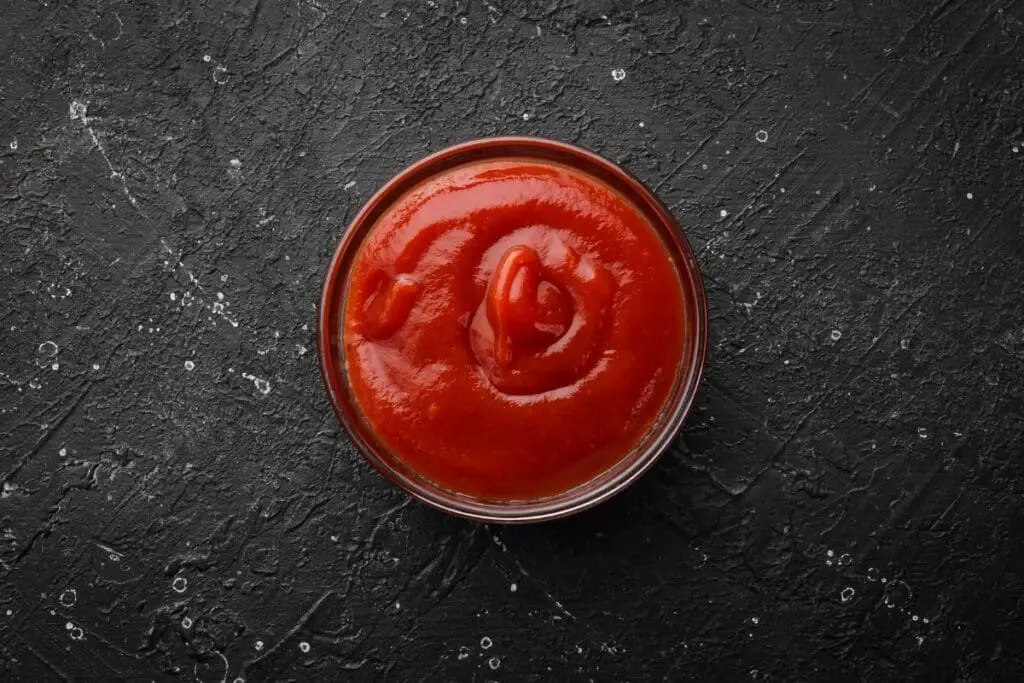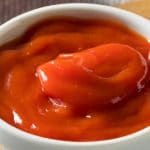Tomato paste substitutes include homemade tomato paste made from pureed tomatoes, tomato puree, tomato-based pasta sauce, canned tomato products, etc. We also provide guidelines for using each substitute effectively based on the dish’s requirements.
It’s pizza night, and you can’t wait to get your homemade pie in the oven until you realize you’re missing a key ingredient, tomato paste. Before you send your significant other to the store in a panic, there may be a quicker solution in your pantry already.
In this guide, we’ll help you conquer your pizza-night dilemma (or any tomato paste shortage for that matter). Before we get into the best substitutes for tomato paste, let’s look at what makes it different from other tomato products so you can choose your replacement accordingly.
What is Tomato Paste?
Tomato paste has a rich red color and thick, spreadable consistency. Tomatoes are cooked for a few hours to evaporate and reduce the water content. The skins and seeds are strained, after which the liquid continues to cook to reduce further, thicken, and intensify in flavor.
Commercially produced tomato paste generally contains some kind of preservative to enhance its shelf life. The salty tomato paste is available in a can, tube, or sachet. When unopened, it can last up to 6 months. However, once that can is opened, the shelf life shortens significantly and will only last between 5 to 10 days. Tubes of tomato paste will last somewhat longer, up to 45 days.
Canned tomato paste is not only for pizza but is used in pasta sauces, soups, stews, chili, bbq sauce, and curry. When choosing a alternative to tomato paste, consider the liquid content of your dish. Stew, soup, curry, and marinades have a liquid and saucy consistency. This gives you more options since a replacement with a thinner consistency can be countered by reducing liquid elsewhere in the recipe.
However, if you are making pizza, using a substitute that is too watery will cause your dough to become soggy. In the below list of tomato paste substitutes, we’ll help you choose the perfect alternative for the specific dish you’re making.
Best Tomato Paste Substitutes
Homemade Tomato Paste
There are various ways to make tomato paste. Although they all entail blending and reducing fresh tomatoes, some methods involve a lengthy slow-bake process after cooking to further remove moisture. For the sake of a pizza night dilemma, we’re going with a less elaborate process here to save you some time. The reduction process will still take a fair amount of time, depending on the quantity and types of tomatoes you’re using.
Although you can use any variety, the best type of tomatoes to use for making a paste are Roma, plum, or San Marzano. Roma and plum tomatoes have fewer seeds and are meaty as opposed to more watery varieties like heirlooms. Using moisture-rich tomatoes will take more time to reduce and will yield less paste.
The number of tomatoes you use will depend on how much paste you want to make and also on the variety of tomatoes you use. As a general guideline, you can expect to yield around 10 tablespoons of paste from 1 pound of tomatoes or work on one medium-size tomato for each tablespoon of puree that you need.
Wash the red fruit and cut off the stem end. Chop them roughly into quarters or halves if they are small. Place the chopped or diced tomatoes into a food processor and blitz until you get a smooth puree.
Now it’s time to strain out the seeds and skin. You can use a sieve or food mill for this. Place your sieve over a deep bowl. Pour the pureed tomatoes into the sieve and let the juices move through while the net catches the seeds and skin. You can always toss the seed remains into the garden to grow your own little red fruits.
Pour the smooth strained puree into a wide saucepan. The bigger the surface area of the pan, the more of the puree will be exposed to heat, allowing excess liquid to evaporate faster. Bring the puree to a simmer on medium-high heat while stirring frequently, and then turn the heat to low.
Add a pinch of salt if desired. Keep stirring to prevent it from burning or sticking to your pan. Reduce the puree on low heat until it becomes thick and most of the liquid has evaporated. Scoop the mixture onto a large plate and spread it out to allow it to cool. This allows it to thicken a little more. Now, where’s that pizza dough?
If you have any of your own tomato paste left, store it in an airtight container in the refrigerator with a thin layer of olive oil drizzled over the top.
Tomato Puree
Probably the best tomato paste alternative, puree comes in cans or sometimes in plastic tubs. The consistency is thinner and more watery than paste, so it’s not suitable for dishes where the thick consistency of the paste is essential. It also has a less intense flavor, although still prominent.
If you have tomato purée at home but need a thicker consistency, you can reduce it down over low or medium heat as with the homemade version. If you’re making pizza, this will be essential to prevent your crust from turning soggy due to the high moisture content.
If you’re making a stew that requires a similar taste, this is an ideal alternative. Decrease the amounts of liquid added to your stew slightly to compensate for the excess moisture in the puree.
Substitute quantity: Replace one tablespoon of paste with 2 to 3 tablespoons of puree. If you need the thick consistency and decide to simmer the puree to thicken it, replace it in equal quantities once thickened.
Best for: Soup, stew, chili, curry, and sauces. It will only be suitable for pizza or other baked items if reduced and thickened.
Tomato-Based Pasta Sauce
Pasta sauces and marinara sauce come ready-prepared in pouches or glass bottles. Although this option will have some other herbs and spices included and is somewhat thinner, it can be used to substitute tomato paste.
Check the ingredients of the sauce since additions like basil or oregano may not go with the flavor profile of your dish. The tomato flavor is not quite as concentrated, so you’ll need to use more to get the same intensity.
Substitute quantity: Replace one tablespoon of tomato paste with 2 tablespoons of pasta sauce.
Best for: Soups, sauces, and stew with a similar flavor profile to the sauce you’re using.
Canned Tomato Products
Canned types can either be whole, diced, or stewed tomatoes. They are packed in a lot of liquid, so you will want to drain off the liquid before measuring it out for your recipe. The flavor is not as concentrated, so you’ll need to use twice the amount to achieve the same intensity.
If you’re making a stew, using crushed tomatoes will be suitable; however, if you’re making a sauce or want a silky soup, you may want to blend it first to get a smooth consistency. Keep in mind that you need to drain it before blending; otherwise, you’ll be left with a very watery product.
As with puree, you can reduce this down over low heat if you need something thicker.
Substitute quantity: Replace one tablespoon of paste with 2 tablespoons of canned tomatoes.
Best for: Soup, chili, stew, and curry.
Tomato Powder
This powder is made from dehydrated and ground tomatoes, bringing a concentrated tomato flavor for a tasty dinner. The great thing about the powder is that it lasts a long time, so you don’t have to worry about anything going to waste if you only need a teaspoon at a time.
This great tomato flavor powder can be reconstituted to a paste, used to sprinkle on veggies, added to baked items, and used in a spice rub.
Substitute quantity: To make a paste, add two parts powder to one part water and mix well to a smooth paste consistency.
Best for: Soup, stew, chili, sauces, curry, marinades, and baked items.
Red Pepper Puree
If tomato is not a significant flavor in your dish but is added as a boost of color and flavor complexity, red pepper paste can be used as an alternative. You can either roast and skin some red peppers yourself or use a jar of roasted red peppers. Puree them until smooth, and your replacement is ready. This won’t give the same tomatoey taste but will add a great depth of flavor that may just become your new secret ingredient.
Substitute quantity: Use the pepper puree in equal quantities.
Best for: Stews and tagine.
Tomato Soup
Tomato soup can be used as a low carb tomato paste substitute; however, it is much thinner than a paste. Therefore, you might need to add some thickening agent to have the desired consistency.
The flavor is sweeter and not as acidic, so keep in mind that you might not get the same tomatoey punch, but it will add some similar flavor notes and color.
You can up the spices slightly if needed to counter the sweetness. When using soup, you will have to decrease the liquid ingredients in the recipe to prevent it from becoming too runny.
Substitute quantity: Replace the soup in equal amounts and reduce other liquids in the recipe by ½ to ⅓ of the soup quantity. For example, if your recipe calls for ½ cup of paste, replace it with ½ cup of soup and reduce other liquids (such as water or broth) by ¼ cup.
Best for: Soup, stew, chili, and curry.
Ketchup
Ketchup should be your last option since it is much sweeter than paste and also contains vinegar. It will change the flavor profile, but if you’re really in a pinch, give it a try. This will work best in a curry or stew where a lot of other flavors are also prominent, so the sauce will blend in rather than being a standout flavor that may cause your dish to be too sweet or have an artificial flavor.
Substitute quantity: Use ketchup in equal quantities.
Best for: Stew or curry where only a small amount is required.
FAQ
Conclusion
Tomato paste is rich and concentrated, adding a big punch of flavor in small amounts. The most important thing when choosing the best tomato paste substitute is the suitability of the consistency.
Puree and canned tomatoes can be reduced over low heat to attain a thicker consistency. If they are used in their original watery form, you will have to adjust the liquid ratios in the recipe, especially if you are using more than one or two tablespoons. As always, taste your sauce during cooking to ensure you get the perfect flavor balance you’re after.
See more: Best substitute for tomato sauce
*image by yarunivphoto/depositphotos









